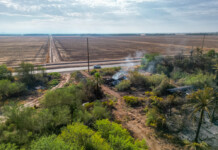
The majority of people voting in InMaricopa.com’s weekly poll were not worried about getting West Nile Virus, despite the first human case being reported in Pinal County Aug. 7.
Seventy-one percent of poll respondents, or 134 people, said they weren’t concerned about the mosquito-transmitted disease. Fifty-four readers, or 29 percent, said they were.
So far this year, there have been seven cases of the virus statewide but only one of those occurred in Pinal County. One person in Maricopa County died.
However, health officials warn there likely are more cases, but they are going unreported because the infected people are part of the 80 percent of infected people who will show no symptoms of the disease.
Those who do present symptoms, however, can experience everything from vomiting and fever to paralysis or even falling into a coma.
The virus was first isolated in 1937 in the West Nile District of Uganda, according to the Centers for Disease Control.
During the 1950s, it was attributed to elderly patients getting meningitis or encephalitis in Israel.
The virus began appearing in equine populations in Europe during the 1960s but, for all its spreading, did not appear in North America until 1999, when it appeared in both horses and humans.
Fortunately, taking preventative measures against the disease isn’t all that difficult: Avoid being outside between dusk and dawn when mosquitoes carrying the disease are more prevalent. If one must be outside during those times, however, wear long-sleeved clothing and use insect repellent.
The repellent should contain an EPA-registered active ingredient such as DEET, Picaridin or oil of lemon eucalyptus.
Parts of Maricopa have been fogged several times this summer to dampen the growth of mosquitoes. Aircraft spraying begin this week in Dallas where 17 people have died from the virus this year.
To find out more about mosquitoes and West Nile virus, call the mosquito hotline at 866-87-0209, extension 6200 or click here to visit the West Nile virus webpage.

![Province writer opens the athlete’s mind in new book Tom Schuman, a Province resident, poses with a copy of his new book, "My Wide World of Sports," outside his home on May 2, 2024. [Monica D. Spencer]](https://www.inmaricopa.com/wp-content/uploads/2024/05/spencer-050224-tom-schuman-sports-book-web-01-218x150.jpg)







![Maricopa’s ‘TikTok Rizz Party,’ explained One of several flyers for a "TikTok rizz party" is taped to a door in the Maricopa Business Center along Honeycutt Road on April 23, 2024. [Monica D. Spencer]](https://www.inmaricopa.com/wp-content/uploads/2024/04/spencer-042324-tiktok-rizz-party-flyer-web-218x150.jpg)

![City gave new manager big low-interest home loan City Manager Ben Bitter speaks during a Chamber of Commerce event at Global Water Resources on April 11, 2024. Bitter discussed the current state of economic development in Maricopa, as well as hinting at lowering property tax rates again. [Monica D. Spencer]](https://www.inmaricopa.com/wp-content/uploads/2024/04/spencer-041124-ben-bitter-chamber-property-taxes-web-218x150.jpg)
![Maricopa restaurateur makes Food Network connection [Namkeen Dhaba]](https://www.inmaricopa.com/wp-content/uploads/2024/04/439456716_377105198650519_7536248579664805896_n-218x150.jpg)

![O’Reilly gears up for second Maricopa location An exterior view of O'Reilly Auto Parts on John Wayne Parkway on May 2, 2024.[Monica D. Spencer]](https://www.inmaricopa.com/wp-content/uploads/2024/05/spencer-050224-oreilly-second-location-web-100x70.jpg)
![Province writer opens the athlete’s mind in new book Tom Schuman, a Province resident, poses with a copy of his new book, "My Wide World of Sports," outside his home on May 2, 2024. [Monica D. Spencer]](https://www.inmaricopa.com/wp-content/uploads/2024/05/spencer-050224-tom-schuman-sports-book-web-01-100x70.jpg)
